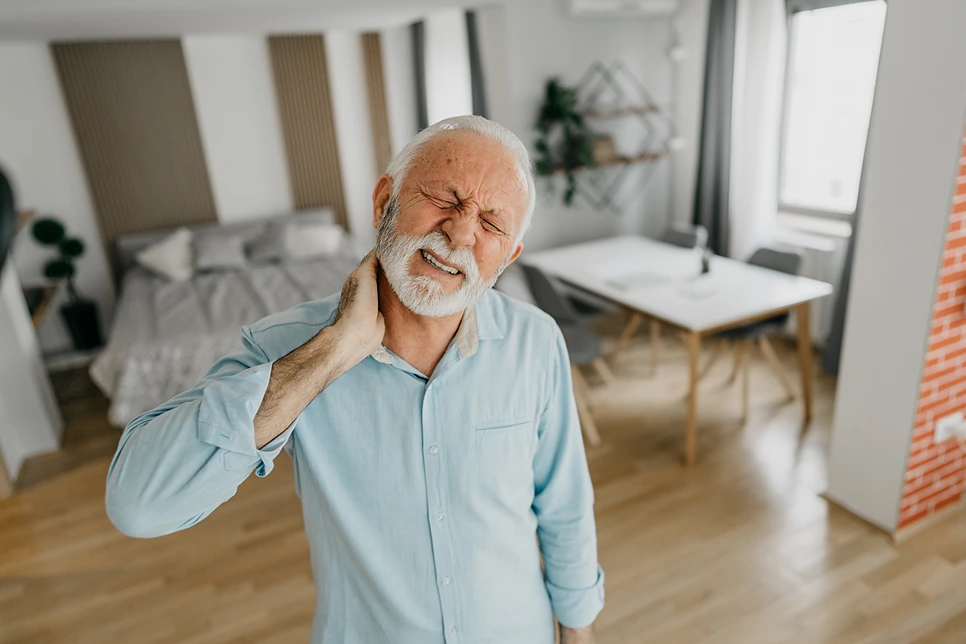Do you ever wake up with an aching pain in your neck or jaw? You’re not alone. Many people experience discomfort on the left side of their neck or jaw.
The causes can vary widely, from sleeping in an awkward position to more serious medical conditions. Getting an accurate diagnosis is your ticket to finding the right treatment.
This guide will explore common reasons for left-side neck and jaw pain, how it’s diagnosed, treatment options, and when to seek help. With the right approach, you can pinpoint the cause and find relief.
Suffering from chronic neck and jaw discomfort? Kaly is your gateway to top-notch specialists for long-term relief.
What Triggers Left-Side Neck and Jaw Pain?

There are many possible explanations for left-side neck and jaw discomfort. Here are some of the most common culprits:
- Muscle Strains: Incorrect posture during the day or sleeping in an awkward position can lead to muscle strain in the neck and jaw. Repetitive activities, like long periods of staring at a computer screen or using a phone without proper support, can also cause muscle tightness and spasms.
- Dental Issues: Conditions like temporomandibular joint dysfunction (TMD or TMJ) and bruxism (teeth grinding) often lead to jaw pain, predominantly on one side. Other dental problems such as impacted wisdom teeth, tooth decay, or gum disease can also cause localized discomfort in the jaw.
- Pinched Nerves: A compressed or irritated nerve in the neck, such as the occipital or mandibular nerve, can result in pain radiating to the jaw.
- Sinus Congestion: Inflammation from sinusitis or allergies can create pressure on nearby nerves, leading to referred pain in the neck and jaw.
- Injuries: Traumatic events like whiplash can cause lasting pain in the neck and jaw area.
- Thyroid Conditions: Issues like thyroiditis can manifest as neck pain, which may extend to the jaw or ears.
- Coronary Artery Spasm: In rare cases, this heart-related issue can cause chest pain that radiates to the neck, jaw, or arm, a symptom often mistaken for musculoskeletal pain.
Triggers for left-side neck and jaw pain range from muscular and dental issues to nerve compression, sinus problems, injuries, thyroid conditions, and, in some cases, cardiovascular issues.
Diagnostic Steps for Left-Side Pain
Determining the root cause of left-side neck and jaw pain involves a multi-step approach, which may include:
Physical Examination
Your doctor will conduct a thorough assessment of the neck and jaw, checking for areas of tenderness, swelling, or redness. They will evaluate your range of motion and alignment to identify muscle tightness or potential nerve involvement.
Visible symptoms like lumps or irregularities in the skin’s texture will also be examined.
Imaging Tests
- X-rays: Useful for examining bone structure and alignment, particularly in the jaw and cervical spine.
- CT Scans: Provide detailed images of bone and soft tissues, helping to identify issues like arthritis or disc problems.
- MRIs: For visualizing soft tissues, including muscles, ligaments, and the temporomandibular joint.
- Electromyography (EMG): If a pinched nerve is suspected, an EMG may be performed to assess nerve function and conduction speed.
Health History Review
Your doctor will inquire about your symptoms, daily habits, previous injuries, and any pre-existing health conditions. Information on any recent incidents, such as dental procedures or neck injuries, will also be considered.
Blood Tests
In some cases, blood tests may be conducted to rule out inflammatory or systemic conditions that could contribute to the pain.
Platforms like Kaly can help connect you to the right specialist, like a dentist, neurologist, or physical therapist, for an accurate diagnosis.
Treatment Approaches for Relief

Once the underlying cause is determined, there are many treatment routes available. Your provider will suggest options tailored to your specific needs.
Medications
Over-the-counter anti-inflammatories like ibuprofen can ease musculoskeletal discomfort. Prescription muscle relaxers may also provide short-term relief. For nerve-related pain, medications like gabapentin help calm nerve irritation.
Physical Therapy
Specific exercises can strengthen the neck, improve range of motion, and reduce muscle tension. Your therapist may use techniques like ultrasound, heat/ice therapy, or gentle joint mobilization. They can also correct posture issues.
Alternative Therapies
Options like acupuncture, chiropractic adjustments, or massage may help relieve muscle tightness and spasms. BUT consult your doctor before starting alternative treatments.
Dental Interventions
If jaw pain stems from dental problems, your dentist may recommend options like mouth guards, braces, surgery for impacted teeth, or TMJ treatment.
Left-side neck pain disrupting your life? Connect with Kaly to find healthcare professionals who can help you reclaim comfort.
Lifestyle Adjustments and Self-Care
There are many ways you can find relief at home:
- Use heat/ice packs: Heat helps relax tight muscles while ice decreases inflammation. Alternate between the two for best results.
- Try OTC pain medication: Anti-inflammatories like ibuprofen can temporarily alleviate discomfort.
- Correct posture: Sit and stand tall, aligning your ears over your shoulders. Avoid hunching over desks and phones.
- Exercise gently: Gentle stretching keeps muscles flexible. Low-impact cardio boosts blood flow. But avoid activities that aggravate pain.
- Manage stress: Anxiety and tension translate into physical discomfort. Try relaxing activities like yoga, meditation, or massage.
- Adjust sleep positions: Sleeping on your back or side with a pillow between your knees may help. Avoid stomach sleeping.
- Watch your diet: Anti-inflammatory foods with omega-3s may ease discomfort. Limit foods that cause inflammation.
Seeking Professional Help

While self-care and over-the-counter medications often alleviate minor neck and jaw aches, it’s important to consult a doctor when:
- Pain Severity and Duration: If the pain is severe, persistent, or lasts longer than a week, professional assessment is necessary.
- Radiating Pain: Pain that extends down your arm or back warrants immediate attention.
- Numbness or Tingling: These symptoms, especially if accompanied by weakness, could indicate nerve involvement.
- Post-Injury Pain: If your pain follows an injury, it’s crucial to get checked for potential underlying damage.
- Functional Impairment: Seek help if pain affects your ability to move, open or close your jaw completely, or perform daily activities.
- Accompanying Symptoms: Fever, headache, neck stiffness, or any other unusual symptoms alongside the pain need prompt evaluation.
- Underlying Conditions: If you have a pre-existing condition like arthritis or fibromyalgia contributing to the pain, professional management is advisable.
Platforms like Kaly are invaluable in connecting you with the right healthcare specialist, be it a primary care physician, chiropractor, dentist, or physical therapist.
Don’t hesitate to seek professional assistance for stubborn or worsening pain. It’s important to act quickly to address health problems and prevent further complications.
The Takeaway
If you’re dealing with recurring neck and jaw discomfort on your left side, don’t ignore it. From poor posture to dental issues, many treatable problems could be the culprit.
Work with your healthcare provider to pinpoint the source. Together, you can explore medication, therapy, dental care, and lifestyle changes tailored to your needs.
Finding the right treatment approach provides lasting relief so you can get back to pain-free living.
Additional Questions About Left-Side Neck and Jaw Pain
Could Left-Side Neck Pain Radiate to the Jaw?
Neck pain, especially due to muscle strain or nerve compression, can sometimes radiate to the jaw area. It’s important to have a physical examination to determine the underlying cause.
Is Left-Side Jaw Pain a Sign of Heart Attacks?
While jaw pain can be a symptom of heart attacks, it’s more commonly associated with dental or muscular issues. However, if jaw pain is accompanied by chest pain or other heart attack symptoms, it should be treated as a medical emergency.
How Does Physical Therapy Help with Jaw Joint Pain?
Physical therapy can be effective in treating jaw joint pain, often caused by TMJ disorders or muscle tension. Therapists may use exercises to improve jaw movement and reduce pain.
What Role Does Dental Care Play in Managing Left-Side Jaw Pain?
Proper dental care is crucial in managing left-side jaw pain, especially when it’s related to conditions like gum disease, wisdom teeth problems, or misaligned teeth. Regular dental check-ups can help prevent or treat these issues.
What’s the Link Between Jaw Bone Health and Left-Side Jaw Pain?
The health of the jaw bone is directly linked to jaw pain. Conditions like osteoarthritis or jaw bone infections can cause pain, particularly on the affected side. Left-side jaw pain might indicate an issue with the left jaw bone.
Are Myofascial Pain Syndrome Symptoms Common in Left-Side Neck and Jaw Pain?
Yes, myofascial pain syndrome, which involves painful muscle knots, can cause persistent pain in the neck and jaw areas. If these knots are located on the left side, they can lead to left-sided neck and jaw pain.
Tired of dealing with left-side neck and jaw discomfort? Kaly links you to the best providers for effective diagnosis and treatment.
